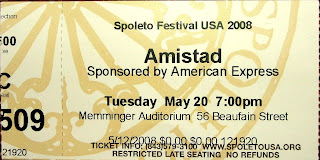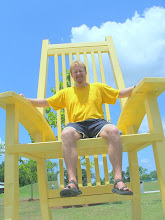
Last night I saw the dress rehearsal of Amistad. There were two arias from the performance that I believe would work well as pieces for students to analyze in my Language Arts classes.
Aria #1: "I could tell"
The first aria came in the third scene of the first act. The scene is titled "Ankle and Wrist" and it begins with the perimeter of the stage encircled by armed men chanting "Ankle and Wrist". It is in the middle of this that Margru, an African female, sings the aria "I could tell". Her song laments the loss of her babies when she was forced into captivity.
Aria #2: "Skin of Clouds"
This aria is sung by the Goddess of the Waters. It recalls the horrors of the Middle Passage from the point of view of this traditional African Goddess. In an exasperated tone she describes how the humans sweet offerings of "sweets and flowers" have been replaced by the "blood and sinew" of bodies falling through her body of water. The aria ends with the following disturbingly written images of horror and injustice:
I tell the heavens,
I tell the earth,
gods of all the living
and the dead,
the waters will rise up
with the moon
and crush the rims of the earth.
This howling is not of the seas.
This death defiles my body,
dares to take my children,
rip them from the land.
This howling is not of the seas.
It is a madness,
not of nature,
not of the gods,
but of men.
I tell the earth,
gods of all the living
and the dead,
the waters will rise up
with the moon
and crush the rims of the earth.
This howling is not of the seas.
This death defiles my body,
dares to take my children,
rip them from the land.
This howling is not of the seas.
It is a madness,
not of nature,
not of the gods,
but of men.
This aria would be an especially powerful addition to a social studies unit on the Middle Passage.
Click the link below to view the opera unit I created for my Honors European Literature students this year.


